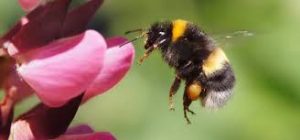06
May
Flight Distance of Bumblebees Impaired by Pesticide, Leads to 87% Decline in Accessible Forage Area
 (Beyond Pesticides, May 6, 2019) Beleaguered pollinators deal with a multitude of human-engineered threats: habitat fragmentation and loss via development and agricultural intensification, ecosystems and food sources tainted with toxic synthetic pesticides, and shrinking food sources via habitat and biodiversity loss. Research out of the Imperial College of London shows that such challenges are exacerbated, for bumblebees, by another impact of pesticide exposure — impaired flight endurance and dynamics.
(Beyond Pesticides, May 6, 2019) Beleaguered pollinators deal with a multitude of human-engineered threats: habitat fragmentation and loss via development and agricultural intensification, ecosystems and food sources tainted with toxic synthetic pesticides, and shrinking food sources via habitat and biodiversity loss. Research out of the Imperial College of London shows that such challenges are exacerbated, for bumblebees, by another impact of pesticide exposure — impaired flight endurance and dynamics.
Published in the journal Ecology and Evolution in late April, ”Pesticide exposure affects flight dynamics and reduced flight endurance in bumblebees” examines how acute exposure to the neonicotinoid imidacloprid affects the nature of bumblebee foraging flight. The study’s researchers find that worker bumblebees so exposed exhibit significant diminishment of flight endurance — measured as both distance and duration — to approximately one-third of what control workers demonstrate. This new information, aggregated with the many other factors that threaten pollinators, points to the importance of ending the use of chemical controls, such as the neonicotinoid imidacloprid, and transitioning to organic systems of agricultural pest management that do not rely on toxic compounds that harm wildlife, ecosystems, water resources, and humans.
Previous research has shown numerous impacts of pesticide exposure on bumblebees, and of neonicotinoid exposure, in particular, including: reproductive failures, alteration of gene expression, harmful changes in attraction to food sources, reduced colony nurturance activity, and decreased foraging activity, as well as colony size. Although acute exposures to pesticide residues may not be lethal to bumblebees, these sublethal effects on them and their behaviors can cause very significant degradation in colony functioning and health.
Flight capacity is obviously critical to bumblebee health and survival, and to those of the colony. The subject paper adds, “While both control and pesticide‐exposed workers were equally motivated to fly initially, pesticide‐exposed workers had a higher probability of terminating flight before the end of the 60‐min[ute] flight test, which was even evident within the first 100 m[eters]. Intriguingly, pesticide workers exhibited a higher mean velocity compared with control workers, which was underpinned by faster flight speeds over the course of the first ¾ km, both during and after which we observed a considerable proportion of pesticide workers terminating their flight. Furthermore, our results suggest that pesticide exposure may negate the capability of larger workers to fly longer distances than their smaller sister workers. . . . Our flight tests suggest that imidacloprid‐exposed bumblebee workers experienced a rapid demotivation to fly as the test progressed and/or tired quickly leading to premature physical exhaustion.”
The study used a “controlled tethered flight mill,” equipment that allows the bees to fly in a laboratory, rather than in situ, but lets scientists measure numerous aspects of that flight, as well as pre- and post- status of the insect controls and those exposed to imidacloprid. The research shows that exposure to the neonicotinoid seems to impair not initial motivation to fly, but flight stamina. The compound has previously been implicated in degraded honeybee energy metabolism, and in reduced activity in the mitochondria (cellular energy centers) in bumblebees and honeybees, which could potentially cause rapid muscle fatigue and, thus, foreshortened flights. The faster flights may be explained by the increased neuronal activity shown to be a function of neonicotinoid exposure.
When bumblebees fly to forage for food, they need the stamina to get to the sources, and then return to the nest. Researchers proffer a necessary minimum, round-trip, flight distance range for them of .68–4.4 kilometers, but note that the pesticide‐exposed worker bumblebees flew shorter distances, on average, than the lower limit of this range. Exposure to imidacloprid appears to have reduced total flight distance by nearly 1.2 km, on average, which represents a 64% reduction compared to the average flight distance of the research controls. The dramatic net metric, however, lies in researchers’ conclusion that this difference would lead to an 87% decline in the total foraging area accessible to a colony — reducing the diversity, nutritional quality, and abundance of food available. Thus, exposures to neonicotinoid pesticides — which are very commonly used, particularly as plant seed coatings, despite questionable utility — have the potential to stress, significantly and cumulatively (with other stressors), the success of bumblebee colonies and their role as critical pollinators, never mind their survival.
Pests can be prevented and managed safely without the use of neonicotinoid or other pesticides. Pollinators can be protected through improved public policy and regulation, and smart choices by home and land owners. As Beyond Pesticides has written, “There is an alternative to the indiscriminate poisoning of pollinators and ecosystems. A solution exists that is effective, productive, economically viable, and sustainable and does not require yet another new toxic pesticide or genetically engineered crop: organic land management. By respecting the environment, the complexity and benefits of interconnected ecosystems, organic agriculture protects pollinators and enhances the benefits we derive from the natural environment.”
See Beyond Pesticides’ Eating With a Conscience for information on why organic is the right choice, and the Bee Protective Habitat Guide and Bee Protective webpage for additional resources for going organic and safeguarding pollinators. In addition, find information on pollinator-friendly seeds and plants here.
All unattributed positions and opinions in this piece are those of Beyond Pesticides.
Source: Ecology and Evolution










